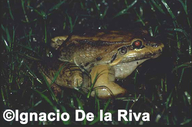|
Description
Leptodactylus bolivianus is a medium to large sized frog in which females have a snout-vent length of 61.2 – 107.7 mm (mean of 85.3 mm) and males have a snout-vent length of 79.0 – 121.5 mm (mean of 104.6 mm). Adult males have chisel-shaped thumb spines. Toes are fringed, heavy dorsolateral folds are present from behind eye to the sacrum, then faint beyond sacrum. A lighter area is present from below the nostrils to beyond the tympanum, above the lip. Body shape is raniform (Heyer and de Sá 2011).
This species is consistently identified from other members of the L. bolivianus complex by the presence of a single chisel shaped spine on the thumb of sexually mature males. It has no spines on the chest, but has fringed toes and is raniform in shape (Heyer and de Sá 2011).
In life, Leptodactylus bolivianus is a light brown to tan frog. It has darker (chocolate) spots and leg bars. Upper lip is light in color. Vent is very light tan. Overall dorsal coloration is light brown, usually with light patterning. The hind limbs exhibit faint to moderate oblong blotches and spots, which appear as bars. Ventral coloration very light (Heyer and de Sá 2011).
Distribution and Habitat
Country distribution from AmphibiaWeb's database: Bolivia, Brazil, Colombia, Peru, Venezuela
Leptodactylus bolivianus can be found in western Brazil, Bolivia, southern Venezuela, southeastern Colombia and Peru. The species occurs in the Amazon basin from about Manaus, Brazil west to the Andean foothills up to 1400 m ASL (Heyer and de Sá 2011). However, records from Ecuador were not examined in Heyer and de Sá’s description of the L. bolivianus complex and thus there is potential for the species to be found in Ecuador as well.Life History, Abundance, Activity, and Special Behaviors
Leptodactylus bolivianus is a large, burrowing, nocturnal species that occurs in a variety of habitats including open grassland, humid and dry lowland forest, secondary forest, swamps, and agricultural fields. They are thought to create their burrows and are associated with water sources – permanent, marshes, and temporary ponds. Breeding is assumed to take place in the early or mid rainy season. Eggs are laid in foam nests on top of the water hidden by vegetation. Larvae are believed to develop in muddy, shallow ponds (Solis et al. 2004).
Leptodactylus bolivianus advertisement calls consist of 1-2 notes with a rate of 0.5/seconds and duration of 0.12 – 0.16 seconds on a modulated amplitude. The call starts at a low frequency (130 – 200 Hz) increasing to a higher frequency (730 – 780 Hz). The loudest part of the call is the middle. Males exhibit hypertrophied forelimbs, presumably to assist in grasping females during breeding (Heyer and de Sá 2011).
Trends and Threats
There are no known threats to this species, which can be found in many protected areas. It is a common species where it occurs and does not appear to be affected by water pollution (Solis et al. 2004). Comments
Species authorities are Boulenger, 1898; Capocaccia, 1957; and Heyer and de Sá, 2011
This species was previously described as a very wide-ranging, single species. In 2011, Heyer and de Sá defined it morphologically and molecularly, restricting the distribution of L. bolivianus to the Amazon basin from the proximity of Manaus, Brazil west to the Andes.
The specific name refers to the nation of Bolivia where the type specimen was collected (Heyer and de Sá 2011).
A Spanish-language species account can be found at the website of Instituto Nacional de Biodiversidad (INBio).
References
Heyer, W. R., de Sá, R.O (2011). ''Variation, Systematics, and Relationships of the Leptodactylus bolivianus Complex (Amphibia: Anura: Leptodactylidae).'' Smithsonian Contributions to Zoology, 635, 1-58.
Solís, F., Ibáñez, R., Chaves, G., Savage, J., Jaramillo, C., Fuenmayor, Q., Reynolds, R., Caramaschi, U., Mijares, A., Acosta-Galvis, A., Hardy, J., La Marca, E., Manzanilla, J., Bolaños, F. (2004). Leptodactylus bolivianus. In: IUCN 2012. IUCN Red List of Threatened Species. Version 2012.2. www.iucnredlist.org. Downloaded on 01 July 2013.
Originally submitted by: Brian Freiermuth (first posted 2009-11-02)
Edited by: Ann T. Chang (2013-08-14)Species Account Citation: AmphibiaWeb 2013 Leptodactylus bolivianus: Rana-Sapo boliviano <https://amphibiaweb.org/species/3312> University of California, Berkeley, CA, USA. Accessed Nov 21, 2024.
Feedback or comments about this page.
Citation: AmphibiaWeb. 2024. <https://amphibiaweb.org> University of California, Berkeley, CA, USA. Accessed 21 Nov 2024.
AmphibiaWeb's policy on data use.
|
